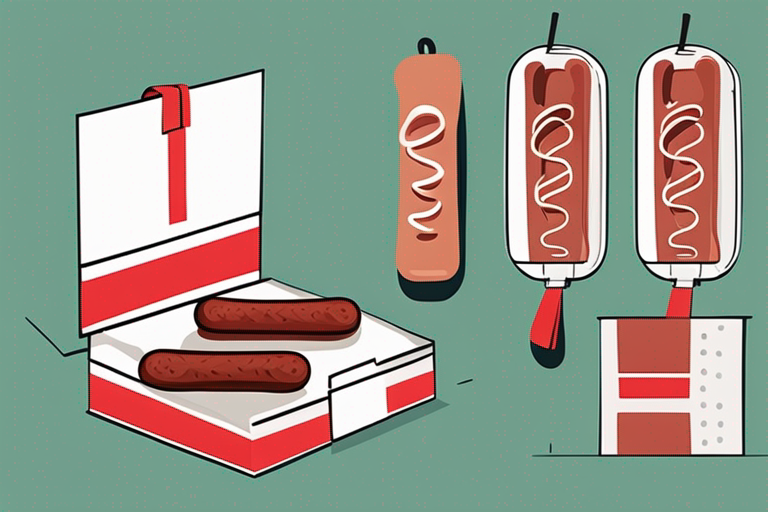
How to Tell if Abruzzese Sausage Dry Opened Has Gone Bad
How to Tell if Abruzzese Sausage Dry Opened Has Gone Bad
Abruzzese sausage is a popular Italian dry-cured sausage that is known for its rich flavor and aroma. However, like any perishable food item, Abruzzese sausage can go bad if not stored properly or consumed within a certain timeframe. In this blog post, we will discuss how to determine if your Abruzzese sausage has gone bad and provide tips on how to store it correctly to ensure its freshness and safety. (Abruzzese sausage dry opened)
Still unsure if This Food is safe?
Every situation is different. Get a personalized food safety verdict for your this food based on the date, storage, and condition — in seconds.
👉 Check Food Safety NowUnderstanding Abruzzese Sausage
Before we delve into how to tell if Abruzzese sausage has gone bad, let's first understand what makes this sausage unique. Abruzzese sausage is typically made from high-quality pork meat, seasoned with a blend of spices, and then cured and dried to develop its distinctive flavor profile. This curing process helps preserve the sausage and gives it a longer shelf life compared to fresh sausages.
Signs Your Abruzzese Sausage Has Gone Bad
It's essential to be able to recognize the signs that your Abruzzese sausage may have spoiled. Here are some indicators that your sausage may have gone bad:
Visual Inspection
- Mold or discoloration on the surface of the sausage
- Slimy or sticky texture
- Dry or shriveled appearance
- Signs of freezer burn (if frozen)
Smell
- Foul or sour odor
- Ammonia-like smell
- Rancid or off-putting aroma
Texture
- Slimy or mushy texture
- Hard or overly dry consistency
If you notice any of the above signs when examining your Abruzzese sausage, it's best to err on the side of caution and discard it to prevent potential foodborne illnesses.
Proper Storage of Abruzzese Sausage
To prolong the shelf life of your Abruzzese sausage and maintain its quality, it's crucial to store it correctly. Here are some tips for storing Abruzzese sausage:
Refrigeration
- Store Abruzzese sausage in the refrigerator at a temperature below 40°F (4°C).
- Keep the sausage wrapped tightly in plastic wrap or aluminum foil to prevent exposure to air and moisture.
- Place the sausage in the coldest part of the refrigerator, such as the meat drawer or the back of a shelf.
Freezing
- If you want to extend the shelf life of your Abruzzese sausage, you can freeze it.
- Wrap the sausage tightly in plastic wrap and then place it in a resealable freezer bag to prevent freezer burn.
- Label the bag with the date of freezing to track its freshness.
Vacuum Sealing
- Consider vacuum-sealing your Abruzzese sausage to remove excess air and help preserve its flavor and texture.
- Vacuum-sealed sausages can be stored in the refrigerator or freezer for an extended period.
Shelf Life of Abruzzese Sausage
While Abruzzese sausage is a cured product and has a longer shelf life compared to fresh sausages, it's essential to consume it within a reasonable timeframe to ensure its quality and safety. Here are some general guidelines for the shelf life of Abruzzese sausage:
- Refrigerated: Consume within 1-2 weeks after opening.
- Frozen: Can be stored for up to 3 months for best quality.
Always check the expiration date on the packaging and follow any storage instructions provided by the manufacturer to ensure the freshness of your Abruzzese sausage.
Conclusion
In conclusion, Abruzzese sausage is a delicious and versatile ingredient that can elevate a variety of dishes. By understanding the signs of spoilage and following proper storage guidelines, you can enjoy your Abruzzese sausage safely and ensure its quality. Remember to trust your senses when determining if your sausage has gone bad, and when in doubt, it's best to discard it to avoid the risk of foodborne illness. With the right storage practices and a keen eye for freshness, you can savor the flavors of Abruzzese sausage without any worries. (Abruzzese sausage dry opened)
Still unsure if This Food is safe?
Every situation is different. Get a personalized food safety verdict for your this food based on the date, storage, and condition — in seconds.
👉 Check Food Safety Now
Still unsure if This Food is safe?
Every situation is different. Get a personalized food safety verdict for your this food based on the date, storage, and condition — in seconds.
👉 Check Food Safety NowAuthoritative Food Safety References
These agencies and university labs inform every tip and health precaution we publish.
USDA FoodKeeper – Cold Storage Guidelines
Official refrigerator, freezer, and pantry timelines maintained by the U.S. Department of Agriculture.
Visit USDA FoodKeeperFDA Produce Safety Rule & Grower Guidance
Field-to-fridge handling practices that prevent contamination of fruits, vegetables, and leafy greens.
Visit FDA Produce SafetyCDC Foodborne Illness Prevention Hub
Surveillance-backed guidance on pathogens, symptoms, and steps to reduce foodborne illness risk.
Visit CDC Food SafetyUC Davis Postharvest Technology Center
University research detailing optimal storage atmospheres for produce after harvest.
Visit UC Davis PostharvestPenn State Extension – Home Food Preservation & Safety
Peer-reviewed extension bulletins on safe canning, chilling, and reheating practices.
Visit Penn State Extension